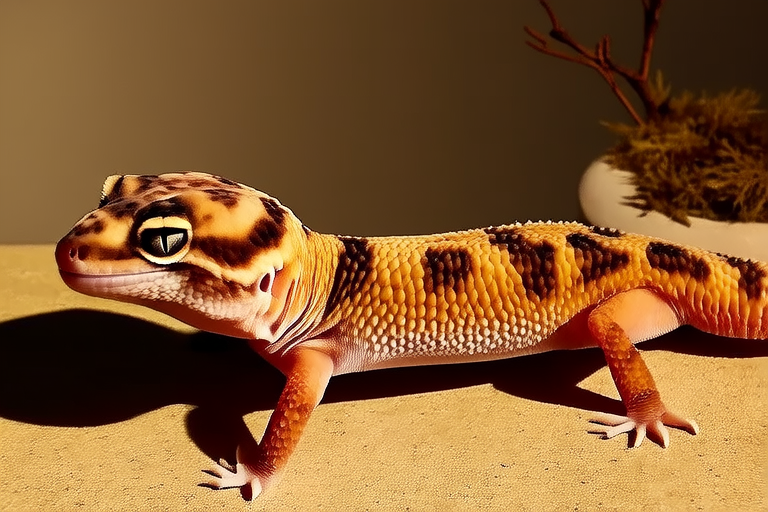Everything You Need to Know Before Bringing Home a Leopard Gecko
Introduction to Leopard Geckos
Welcome to the fascinating world of leopard geckos! These small, docile lizards have become popular pets due to their ease of care, gentle nature, and striking appearance. Originating from the arid regions of Pakistan and Afghanistan, leopard geckos are well-adapted to living in captivity. They come in a variety of colors and patterns, making them visually appealing. With proper care, these geckos can live up to 20 years, offering long-term companionship.
Housing Requirements
Creating a suitable habitat is crucial for your leopard gecko’s health and happiness. Here’s what you need:
- Terrarium Size: A 20-gallon tank is sufficient for one adult gecko, providing ample space for exploration.
- Substrate: Opt for paper towels or reptile carpet for easy cleaning. Avoid sand and wood shavings, which can cause impaction.
- Temperature Gradient: Maintain a temperature gradient with a warm side (88-90°F) and a cooler side (75-80°F).
- Hiding Spots: Offer multiple hiding spots, including caves and tunnels, to mimic their natural environment.
- Humidity: Keep humidity levels low, around 30-40%, to prevent respiratory issues.
- Basking Spot: Provide a heat lamp or ceramic heater on one side of the enclosure.
Diet Specifics
Leopard geckos are insectivores, meaning their diet consists mainly of insects. Here’s how to ensure they get the right nutrition:
- Feeding Schedule: Feed adults every other day, while juveniles require daily feeding.
- Insect Variety: Offer crickets, mealworms, dubia roaches, and waxworms. Dust insects with calcium and vitamin D3 supplements before feeding.
- Calcium Supplementation: Calcium is vital for bone health; use a high-quality supplement.
- Vitamin D3: Ensure adequate exposure to UVB light or provide vitamin D3 supplements to aid calcium absorption.
Health Care Basics
Maintaining good health requires regular monitoring and preventive measures:
- Regular Vet Visits: Schedule annual check-ups with a reptile veterinarian.
- Signs of Illness: Watch for lethargy, loss of appetite, or abnormal skin shedding.
- Common Health Issues: Metabolic bone disease, impaction, and respiratory infections are prevalent.
- Cleanliness: Regularly clean the enclosure to prevent bacterial growth.
Behavior Insights
Understanding your gecko’s behavior helps foster a strong bond:
- Social Interaction: Leopard geckos are solitary animals; avoid housing multiple geckos together.
- Handling: Handle gently, supporting their body fully. Start with short sessions to build trust.
- Nocturnal Nature: They are most active at night, so schedule playtime accordingly.
- Shedding: Assist with shedding by providing a humid hide or misting the enclosure if needed.
Cost Considerations
Bringing home a leopard gecko involves various expenses:
- Pet Purchase: Expect to spend $50-$150 for a healthy, captive-bred gecko.
- Initial Setup: The terrarium, substrate, heat lamp, and other essentials can cost around $200-$300.
- Ongoing Costs: Feeding insects and maintaining the enclosure will add approximately $50-$100 annually.
- Veterinary Care: Plan for occasional visits to a reptile vet, which can be costly.
Tips for Acclimating Your New Pet
Help your gecko adjust smoothly to its new home:
- Set Up Early: Prepare the enclosure well in advance of bringing your gecko home.
- Gradual Introduction: Allow your gecko time to explore its new environment without immediate handling.
- Monitor Behavior: Pay attention to signs of stress or discomfort during the first few weeks.
- Consistency: Maintain a consistent routine for feeding, cleaning, and interaction.
Common Questions and Myths
Separate fact from fiction to ensure you’re giving your gecko the best care:
- Myth: Leopard Geckos Don’t Require UV Light. While they don’t need direct sunlight, UVB lighting helps with vitamin D3 production.
- Question: Can Leopard Geckos Live Outside? No, they are not suited for outdoor living due to their specific environmental needs.
- Myth: Leopard Geckos Are Nocturnal, So They Don’t Need Heat. They still need warmth to digest food properly.
- Question: How Often Should I Change the Substrate? Change it weekly or as soon as it becomes dirty.
For more detailed information, consider consulting books like “The Perfect Setup Leopard Geckos” by Philippe de Vosjoli or joining online forums dedicated to reptile enthusiasts.
